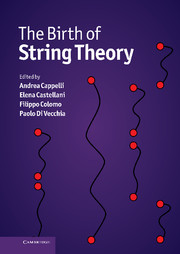Book contents
- Frontmatter
- Contents
- List of contributors
- Photographs of contributors
- Preface
- Abbreviations and acronyms
- Part I Overview
- EARLY STRING THEORY
- Part II The prehistory: the analytic S-matrix
- Part III The Dual Resonance Model
- Part IV The string
- TOWARDS MODERN STRING THEORY
- Part V Beyond the bosonic string
- 27 Introduction to Part V
- 28 From dual fermion to superstring
- 29 Dual model with fermions: memoirs of an early string theorist
- 30 Personal recollections
- 31 Aspects of fermionic dual models
- 32 The dual quark models
- 33 Remembering the dawn of relativistic strings
- 34 Early string theory in Cambridge: personal recollections
- Part VI The superstring
- Part VII Preparing the string renaissance
- Appendix A Theoretical tools of the Sixties
- Appendix B The Veneziano amplitude
- Appendix C From the string action to the Dual Resonance Model
- Appendix D World-sheet and target-space supersymmetry
- Appendix E The field theory limit
- Index
32 - The dual quark models
from Part V - Beyond the bosonic string
Published online by Cambridge University Press: 05 May 2012
- Frontmatter
- Contents
- List of contributors
- Photographs of contributors
- Preface
- Abbreviations and acronyms
- Part I Overview
- EARLY STRING THEORY
- Part II The prehistory: the analytic S-matrix
- Part III The Dual Resonance Model
- Part IV The string
- TOWARDS MODERN STRING THEORY
- Part V Beyond the bosonic string
- 27 Introduction to Part V
- 28 From dual fermion to superstring
- 29 Dual model with fermions: memoirs of an early string theorist
- 30 Personal recollections
- 31 Aspects of fermionic dual models
- 32 The dual quark models
- 33 Remembering the dawn of relativistic strings
- 34 Early string theory in Cambridge: personal recollections
- Part VI The superstring
- Part VII Preparing the string renaissance
- Appendix A Theoretical tools of the Sixties
- Appendix B The Veneziano amplitude
- Appendix C From the string action to the Dual Resonance Model
- Appendix D World-sheet and target-space supersymmetry
- Appendix E The field theory limit
- Index
Summary
Abstract
We briefly recall the historical environment around our 1971 and 1975 constructions of current algebraic internal symmetry on the open string. These constructions included the introduction of world-sheet fermions, the independent discovery of affine Lie algebra in physics (level one of affine su(3)), the first examples of the affine-Sugawara and coset constructions, and finally – from compactified spatial dimensions on the string – the first vertex-operator constructions of the fermions and level one of affine su(n).
Introduction
In this Chapter we describe the environment around our 1971 paper ‘New dual quark models’ [BH71] and the two companion papers ‘The two faces of a dual pion–quark model’ [Hal71c] in 1971, and ‘Quantum “solitons” which are SU(N) fermions’ [Hal75] in 1975, which laid the foundations of non-Abelian current-algebraic internal symmetry on the string.
The background for our contributions included many helpful discussions with other early workers, including H. M. Chan, C. Lovelace, H. Ruegg and C. Schmid (during KB's 1969 visit to CERN), as well as R. Brower, S. Klein, C. Thorn, M. Virasoro and J. Weis (with MBH at Berkeley). Both of us also acknowledge many discussions with Y. Frishman, G. Segre, J. Shapiro and especially S. Mandelstam. Later discussions with I. Bars and W. Siegel are also acknowledged by MBH. With apologies to many other authors then, we reference here only the work which was most influential in our early thinking: before Veneziano, there had been widespread interest in the quarkmodel of Gell-Mann and Zweig, including the four-dimensional current algebra (Adler and Dashen [AD68]) of quarks.
- Type
- Chapter
- Information
- The Birth of String Theory , pp. 393 - 406Publisher: Cambridge University PressPrint publication year: 2012
- 1
- Cited by

